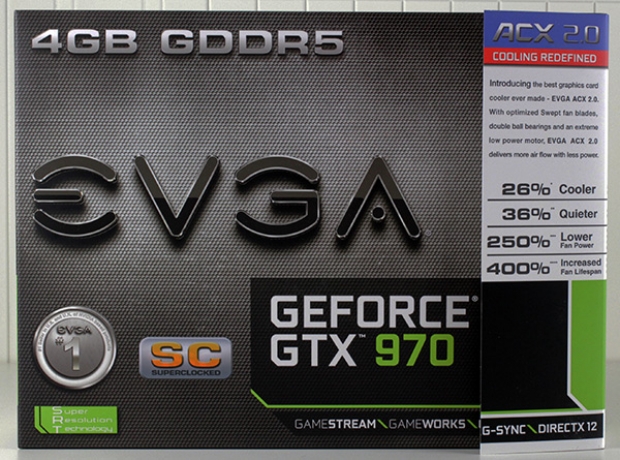Index

Review: For value minded gamers
Nvidia has released two new graphics cards based on its latest Maxwell GPU architecture. The Geforce GTX 970 and Geforce GTX 980 will replace the outgoing Kepler-based Geforce GTX 780 and Geforce GTX 780Ti.
Nvidia gave its AIB partners the green light to offer custom designs from day one, so we are already seeing GTX 970 cards with a hefty factory overclock.
As one of Nvidia’s premier partners, EVGA was one of the first players to launch a range of custom cards. While most AIB partners are offering one or two 900-series cards, EVGA is going a step further, or a few steps with no less than eight different GTX 970 cards. Today we will take a look at one of them – the EVGA GTX 970 Superclocked with the company’s trademark ACX 2.0 dual fan cooler.
The GTX 970 SC ACX 2.0 works at base clock of 1165MHz, while the reference GPU base clock is 1050MHz. Nvidia's GPU Boost 2.0 takes the average GPU clock to 1178MHz for the reference GPU and to 1317MHz for the SC card.
EVGA did not change the memory clock. The GTX 970 SC ACX 2.0 features 4GB of GDDR5 memory clocked at 1750MHz (7000MHz effective), providing up to 224.3GB/sec of peak memory bandwidth.
The next photo shows EVGA’s full GTX 970 line-up. The GTX 970 FTW is 51MHz faster than the Superclocked version.

The new ACX 2.0 cooler is supposed to ensure quiet and cool operation despite the factory overclock, but it should also provide additional overclocking headroom.
Nvidia designed Maxwell to deliver more efficiency and performance. The GTX 980 and GTX 970 are vastly more efficient than their Kepler-based predecessors. The GTX 980 has a TDP of 165W, while the GTX 970 is rated at 145W. The old GTX 780 Ti and GTX 780 have a TDP of 250W. Just like their predecessors both new cards are capable of delivering smooth frame rates at resolutions up to 2560x1600. In case you are planning to build a 4K capable rig, two GTX 970 cards should be enough for good frame rates and anti-aliasing in demanding titles.
GTX 980 and GTX 970 are based on the 28nm GM204 GPU. The GPU packs 5.2 billion transistors and has a die size of 398mm2. The GTX 980 comes with 2048 CUDA cores, while the GTX 970 has 1664 CUDA cores enabled. Three out of sixteen streaming multiprocessors, which each hold 128 CUDA cores, are disabled on the GTX 970.
With the GTX 980 and GTX 970, Nvidia also decided to launch a few new technologies there were not employed in the first incarnation of Maxwell on the GTX 750 series. Voxel Global Illumination, Multi Frame Anti-aliasing and Dynamic Super Resolution are built around old concepts, but they do a good job at reinventing them. Of course, DirectX 12 is supported on all Maxwell cards.
EVGA has released a new version of its very popular Precision X software. This latest version of Precision X (v.16) has been revamped with a new GUI, new OSD (On-Screen Display) features, improved voltage and pixel clock control, integrated Steam Achievements, Improved K-Boost function. The ‘GPU vitals’ area on the main UI is now scrollable and the UI now shows clock and voltage adjustments in real time and more.

The box clearly indicates that the card features an improved ACX 2.0 cooler with new fans.
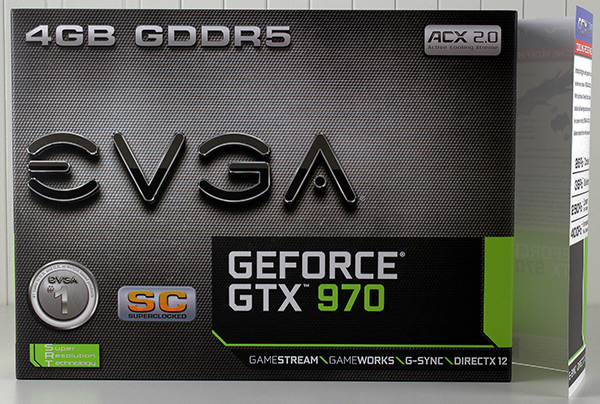
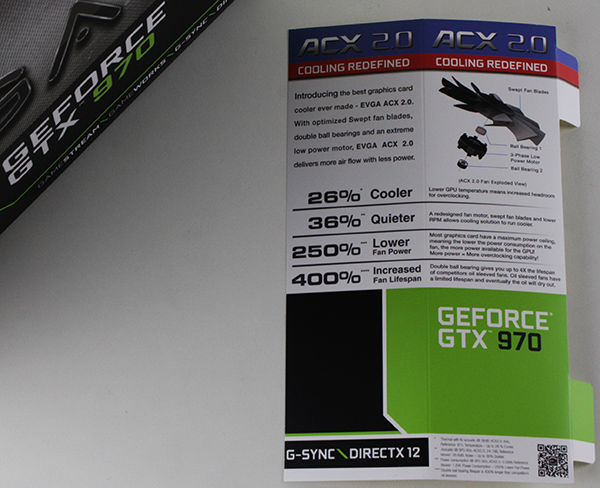
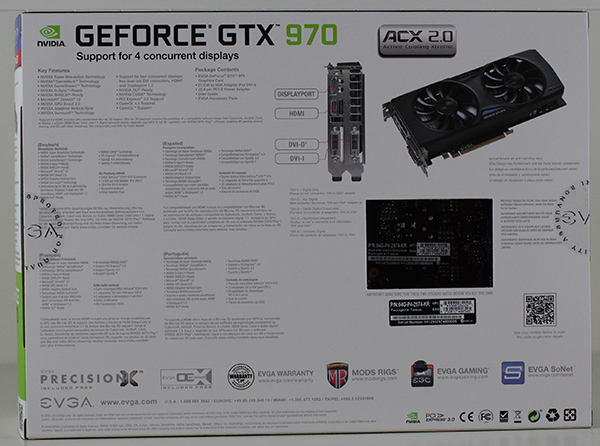
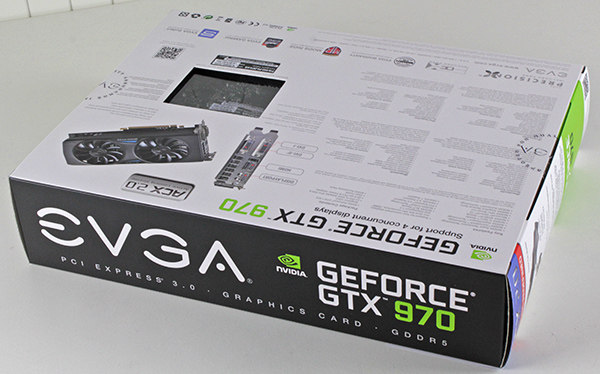
In the box you’ll find:
EVGA Full Size Poster
A user guide and quick installation guide
Info note about new fans
A new sticker set (enthusiast built)
DVI to VGA Dongle
2x Molex to 6-pin Power Adapter

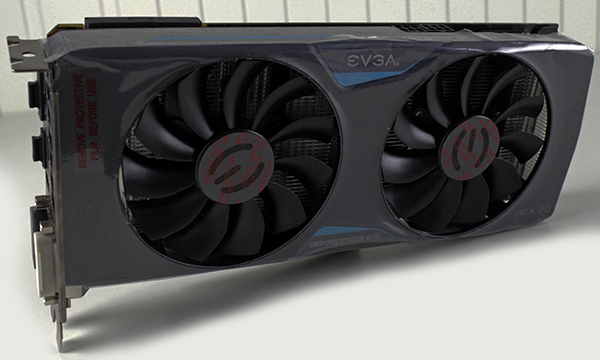
EVGA decided to add a bit of value to the GTX 970 with a custom design and a factory overclock. The new Active Cooling Xtreme (ACX) 2.0 cooler on the GTX 970 Superclocked card has a somewhat different heatsink design compared with the first version which debuted on the GTX 780 Superclocked ACX. The shroud is also visually a bit different, but it is plastic just like the old one. As you can see EVGA also decided to add a splash of blue on the stickers.

Installation requires two slots in your system.
With the ACX/ACX 2.0, EVGA designed a special heatsink with a lot of dissipation surfaces. To maximize dissipation volume, EVGA used a few tricks, such as tall fins at the sides of the cooler. The heatsink was designed in such a way to minimize airflow turbulence between the fans, with clever barriers directing the airflow. Also the heatsink is elongated to match the full length of the PCB.
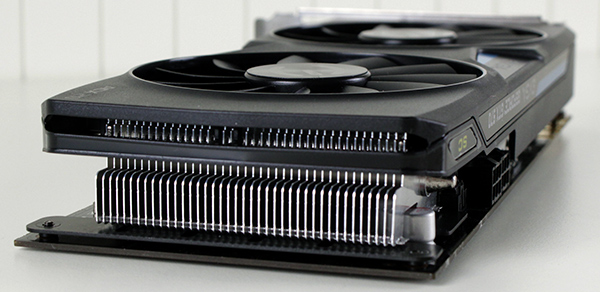
The new fans are said to be more efficient thanks to a new motor. They can hit higher speeds, while the fan blades are designed to deliver more airflow at lower revolutions.
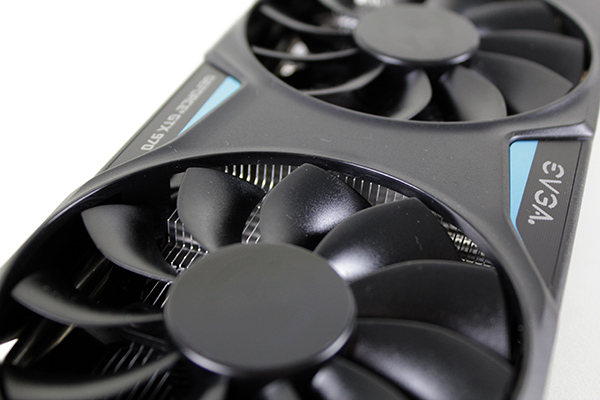
Poor fans are often the weakest link in cooler design and EVGA is fully aware of this fact. That is why it put a lot of effort into tweaking its fans.
The ACX cooler on the GTX 780 Superclocked has 9-blades, but now EVGA uses an 11-blade fan design. The blades are swept. The fan uses a double ball bearing design. The noise generated by ball bearing designs tends to be very low, at least while they are new. However, since this fan uses two ball bearings it should last a bit longer and generate a less noise even after a couple of years of wear.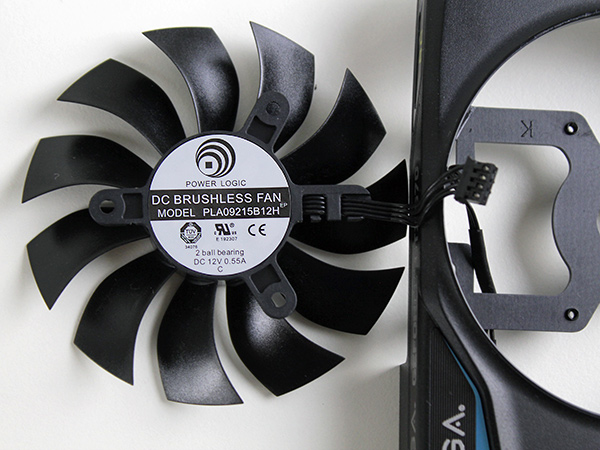
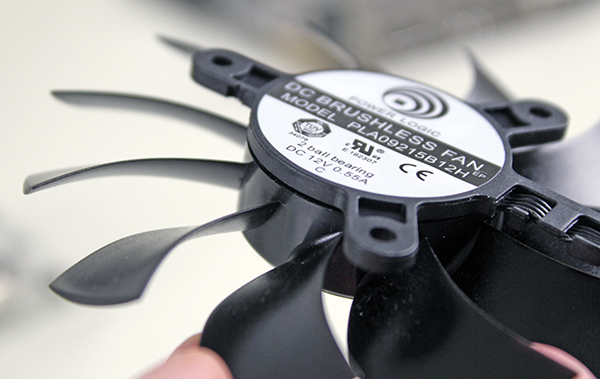
The company even made some promotional materials about the new design.
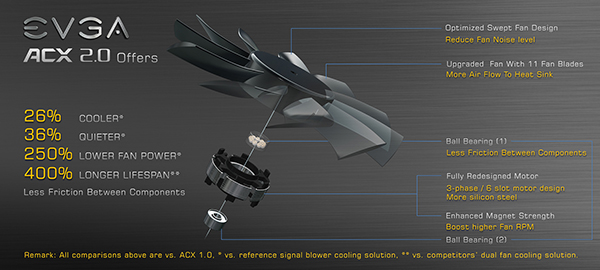
Nvidia’s stock cooler is so good that the company hasn’t changed it in a while and it is used on the flagship GTX 980 as well. The cooler was designed to provide superior cooling performance and generate very little noise in the process. Since it could cope with 250W Kepler-generation cards, it is obvious that the new Maxwell cards pose no problem whatsoever due to their significantly lower TDP.
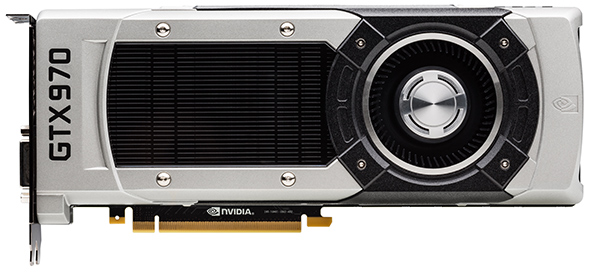
The EVGA ACX 2.0 cooler may not be as visually appealing as the stock unit, but it promises even better performance and low noise at even higher clocks.
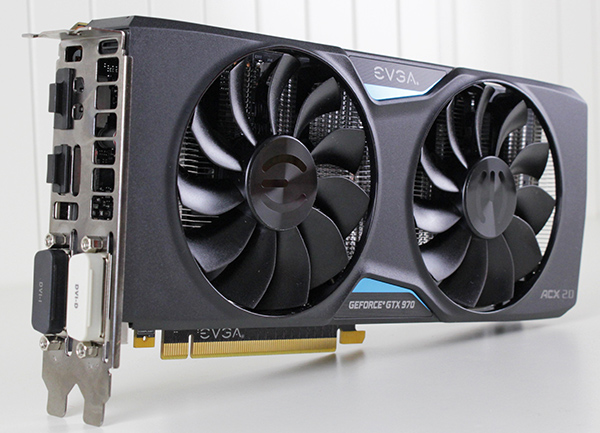
The GTX 970 SC ACX 2.0 is 24.5cm long and it is 11cm tall. Obviously it is a dual-slot design, but it is somewhat smaller than its predecessors. The ACX cooler on the GTX 780 Superclocked ACX is 27cm long.
A 6+6 pin power connection setup is used on the GTX 980 and GTX 970. The GTX 780 Ti and GTX 780 require a combination of 6+8 pin power connectors. The GTX 780, GTX 780 Ti and Titan have a TDP of 250W, compared to GTX 980 with a 165W TDP and GTX 970 with a 145W TDP.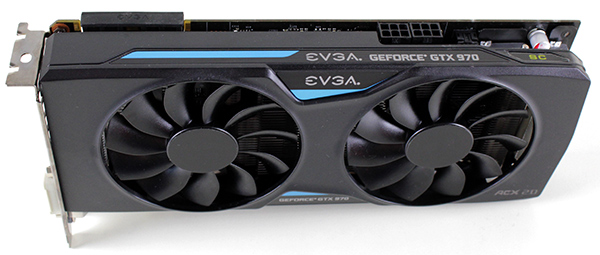
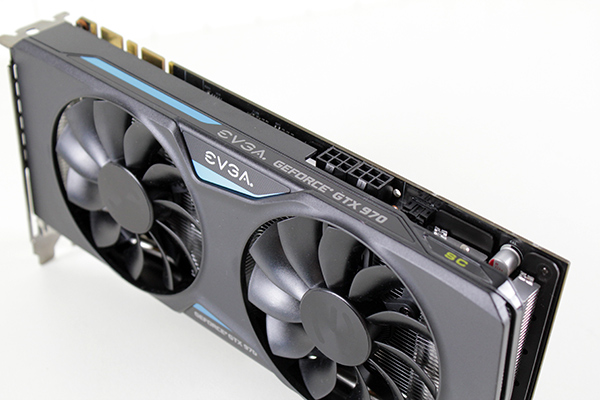
The GTX 980 is built for multi-GPU action. In addition to standard dual-SLI, it can also be used in triple- and quad-SLI setups, as it features two SLI connectors. The fact that this is a dual-slot design also helps.
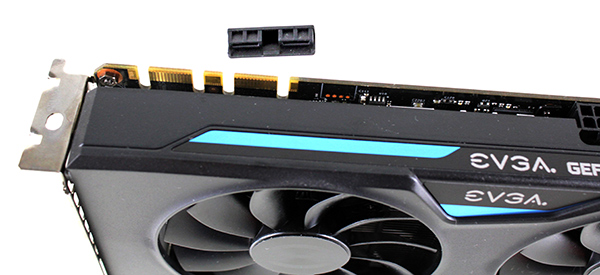
The GTX 970 SC ACX 2.0 features one standard HDMI connector (2.0 compatible, which includes HD audio and Blu-ray 3D movies support), one standard DisplayPort out and two DVI outs (one single-link and one double-link). All four can be used at the same time, just like on the reference GTX 970 card, with difference that the reference card provides different mix of video connectors.
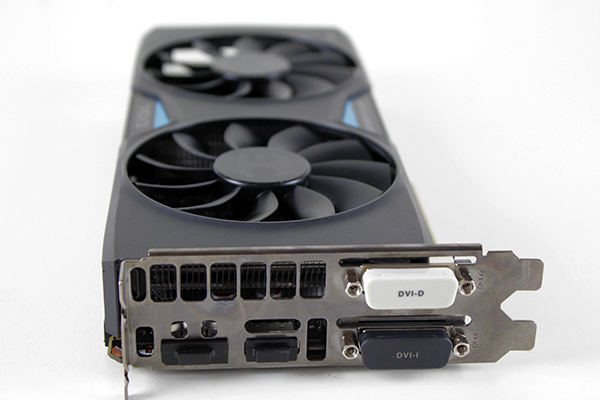
Protective caps are on all video out connectors. The I/O bracket also doubles as an exhaust vent, helping reduce temperatures within the chassis.
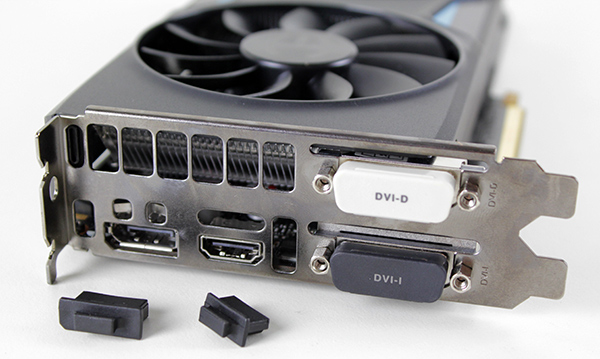
The exhaust vent is much more important on the reference cooler which uses blower style fan (image below). As far as video outputs go on the reference GTX 970, few users will complain, since the reference card features three DisplayPort connectors, an HDMI 2.0 connector (allowing you to run 4K@60Hz), and a dual-link DVI output for a total of five connectors.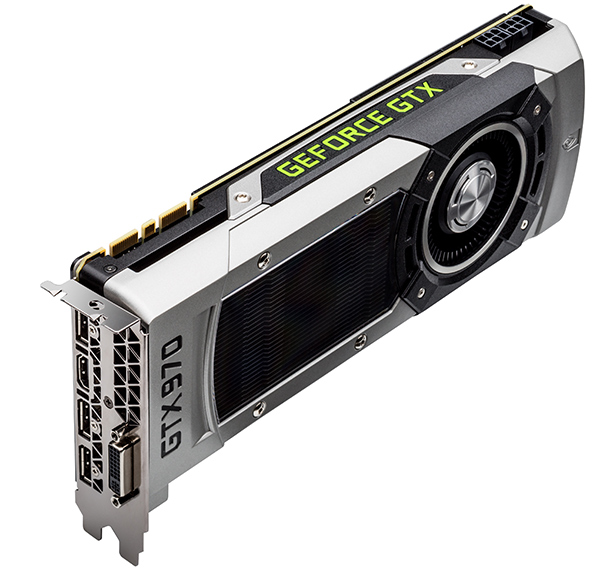
Three G-SYNC displays can be driven from one GeForce GTX 980 / GTX 970 card for instance. It’s important to note that when connecting multiple displays between more than one card, you may see performance differences (similar to previous GPUs). For example, a 3-Way SLI configuration with one display connected to each card, versus plugging all three connectors into the same card.
The GTX 970 SC ACX 2.0 has 4GB of memory, and four of eight memory modules are placed on the back side of the PCB. Our sample shipped without a backplate, but EVGA assured us that backplates will be included on certain SKUs of EVGA GTX 970. Bear in mind that EVGA is offering eight different GTX 970 cards. Even those who decide to purchase a version without a backplate can order one after they register their product and they will receive it free of charge (Updated: free backplaes will be offered only in Europe and only for a limited time).
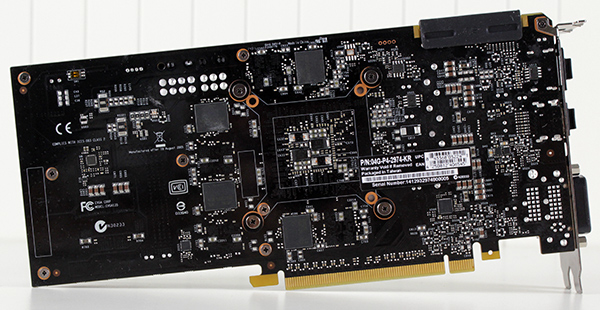
The Samsung chips, (modelK4G41325FC-HC28) are specified to run at 1750 MHz (7000 MHz GDDR5 effective).
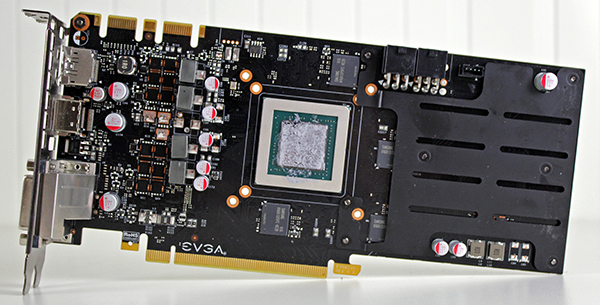
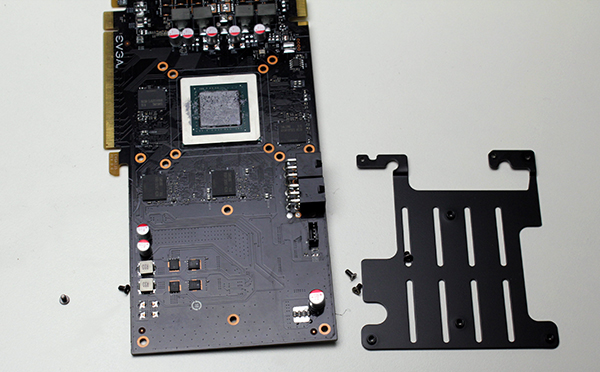
The original ACX cooler for the GTX 780 Superclocked comes with five elaborate heatpipes, while the new ACX 2.0 for the GTX 970 Superclocked comes with only three heatpipes. The way the GTX 970 Superclocked ACX 2.0 heat sink was designed is based on the GTX 970 wattage plus an additional 40% cooling headroom on top of it. There are 3 heat pipes on the heatsink – 2 x 8mm major heat pipes to distribute the majority of the heat from the GPU to the heatsink, and a 3rd 6mm heatpipe is used as a supplement to the design to reduce another 2-3 degrees Celsius. The cooler passed NVIDIA Greenlight specifications.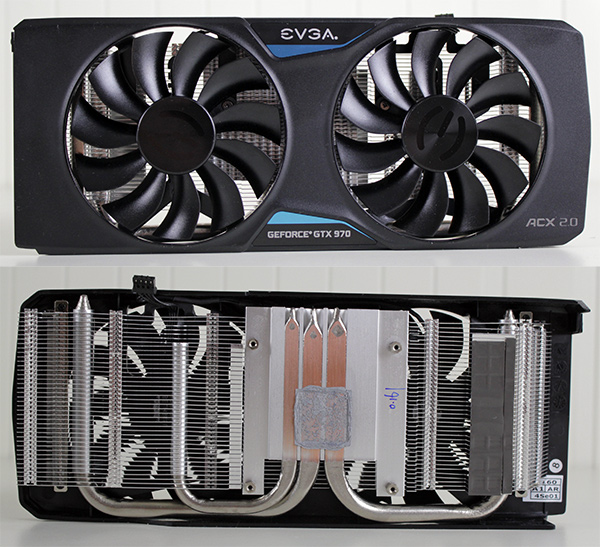
Due to the GPU small die size, EVGA intended for the GPU to contact two major heat pipes with direct touch to make the best heat dissipation, it is not intended to "sit" on the 3rd heat pipe. However you can see that the GPU is overhanging the heat-pipes a little bit on the right. 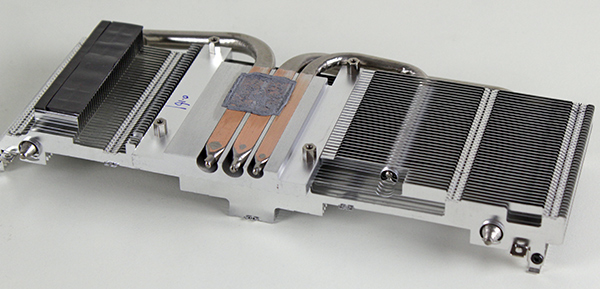
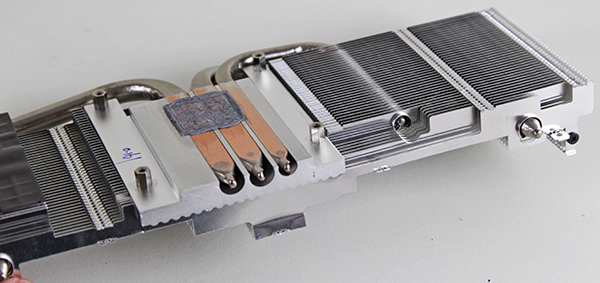
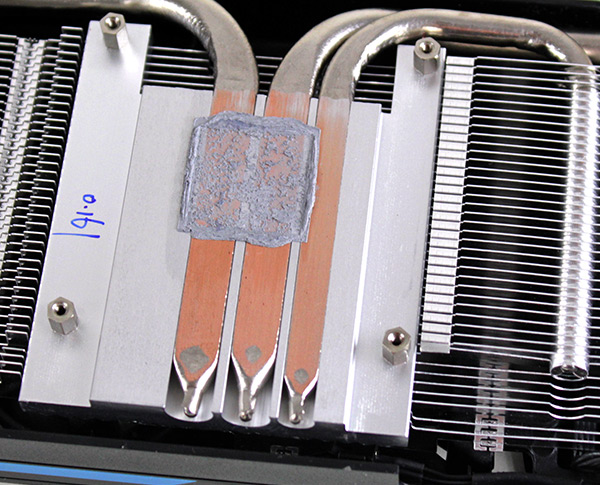
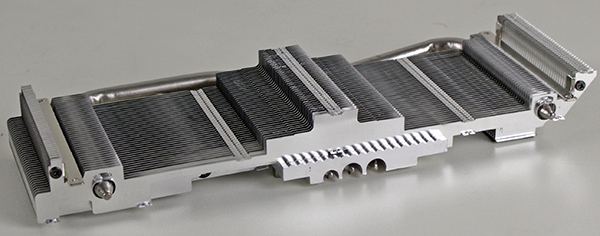
EVGA also has an ACX 2.0 “FTW” version with five heatpipes for those users who want even higher clocks. The Maxwell GPU is an extremely power efficient GPU, and GTX 970 Superclocked ACX 2.0 cooler allows the boost clocks at over 1300MHz.

Testbed:
- Motherboard: Intel DZ87KLT-75K
- CPU: Intel Core i7 4770K, 4x3.5GHz (Haswell)
- CPU Cooler: EVGA
- Memory: 2x4GB Corsair DDR3 2400MHz
- Harddisk: Corsair Neutron GTX 240GB
- Case: CoolerMaster Cosmos II
- Operating System: Win8.1 64-bit
344.07_geforce_win8_winvista_win7_64bit_international.exe
14-4-win7-win8-win8.1-64-dd-ccc-whql.exe
AMD-Catalyst-14.30.1005-Radeon-R9-285-Windows-Aug29
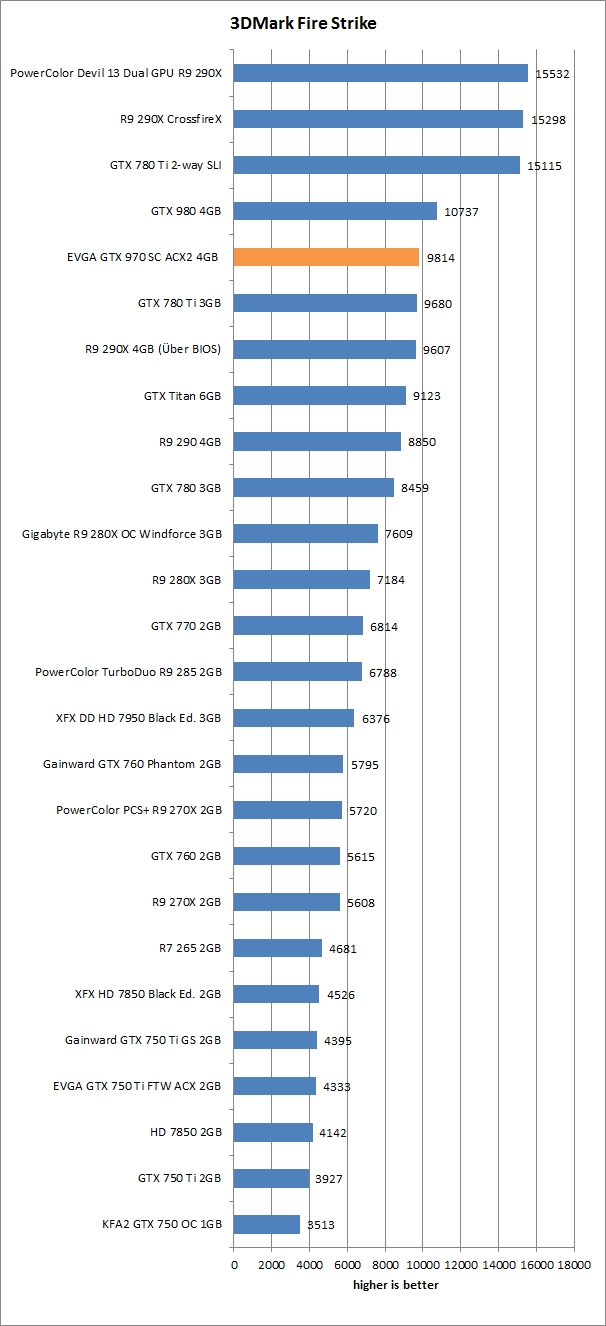
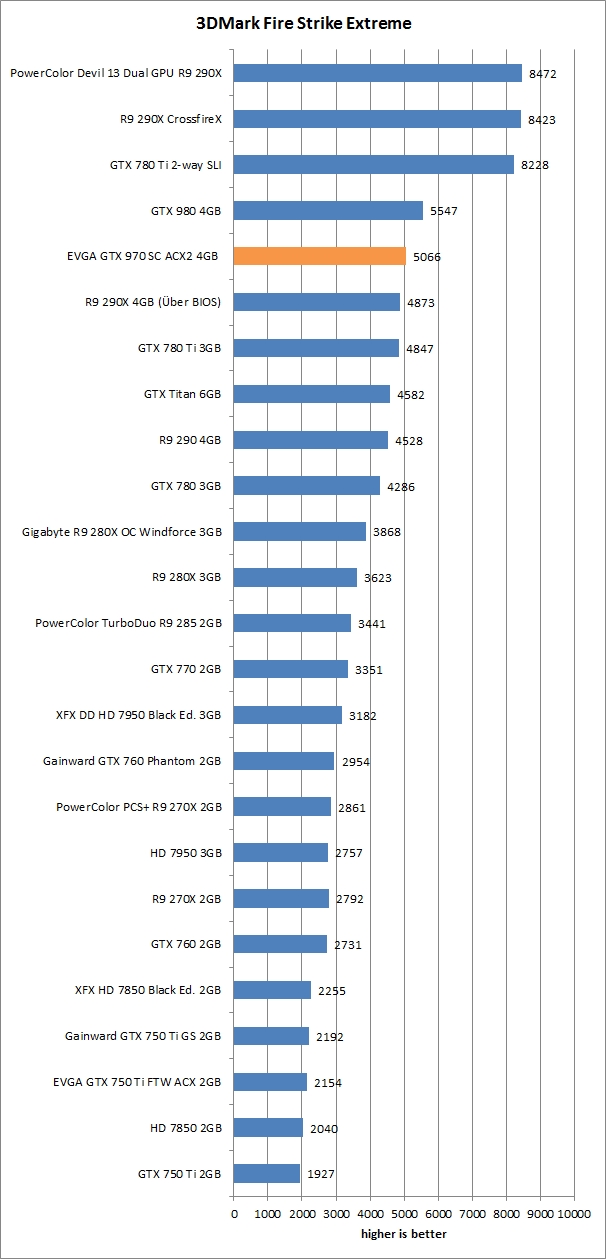
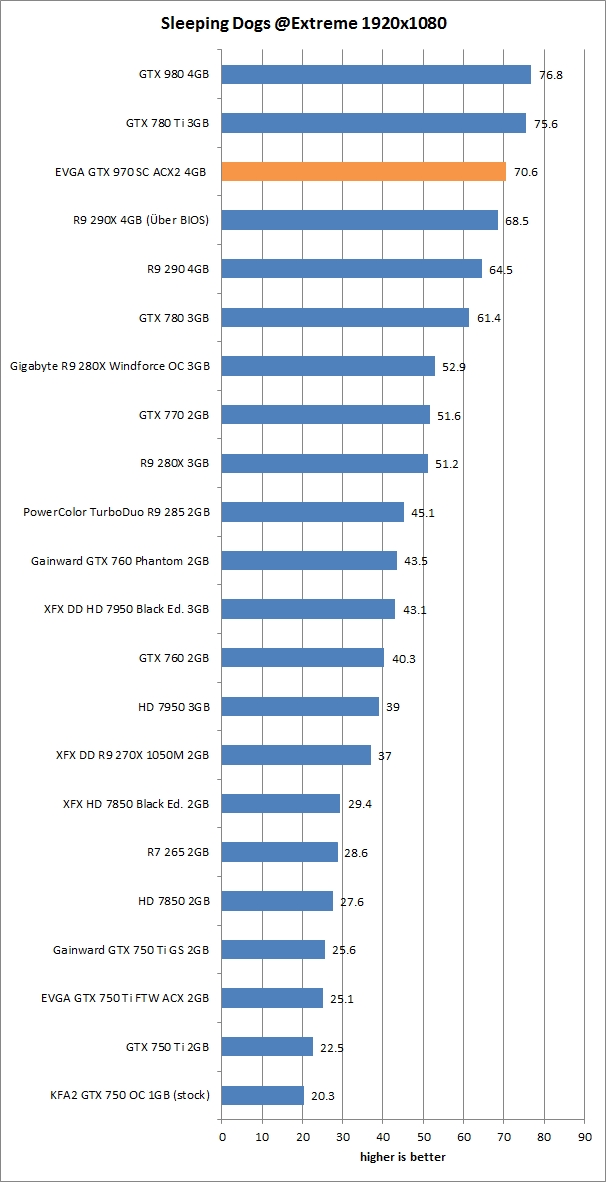
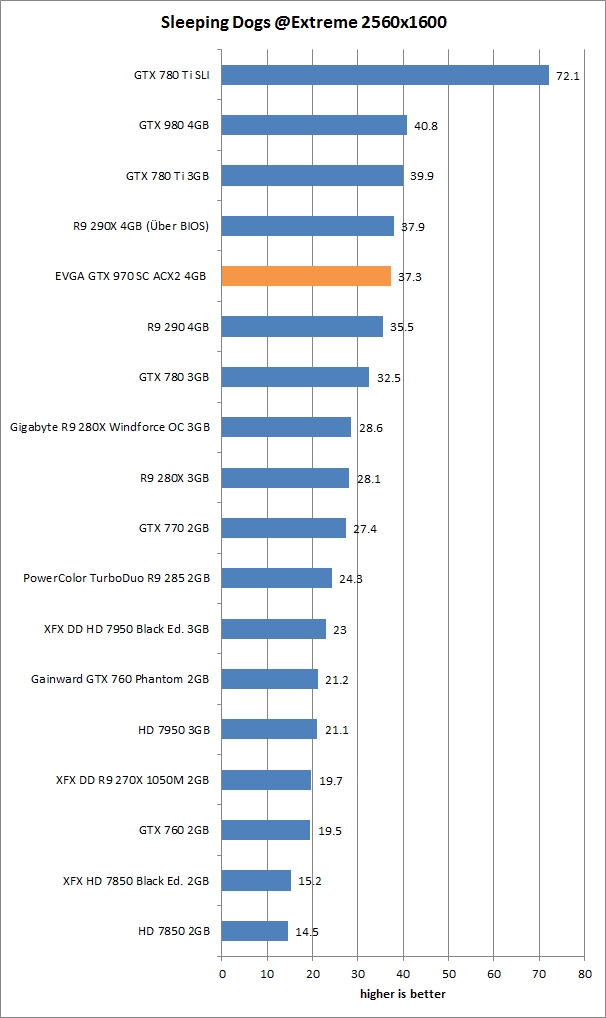
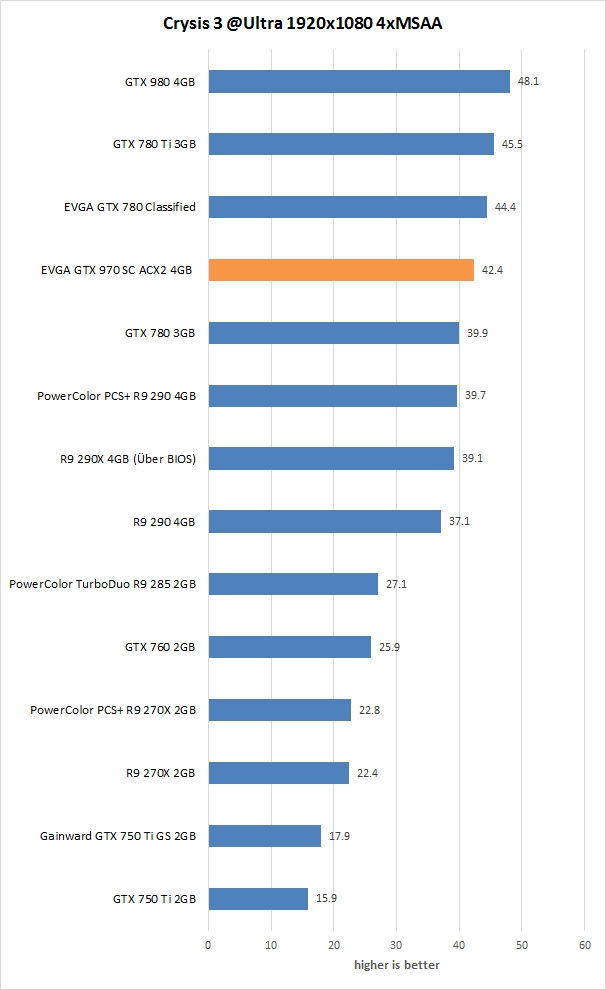
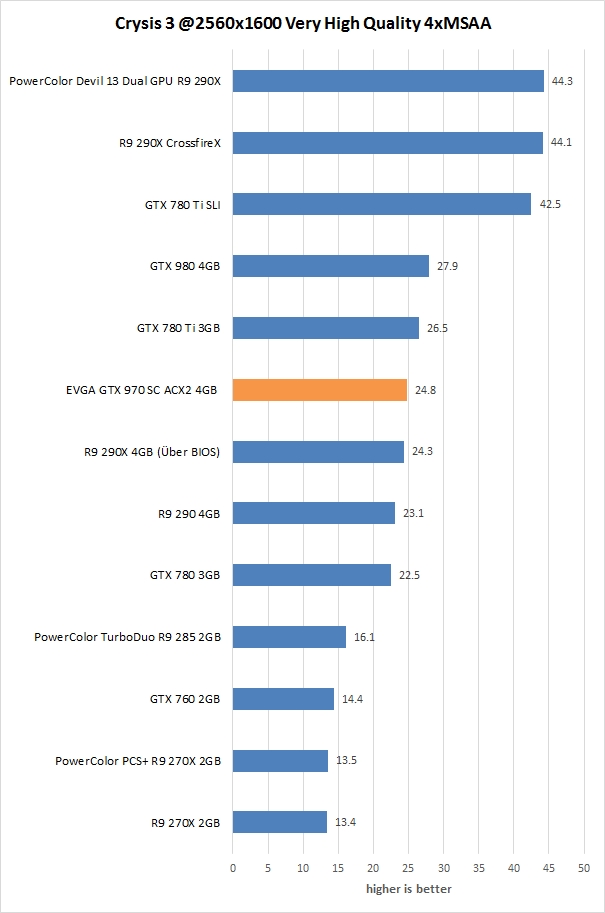
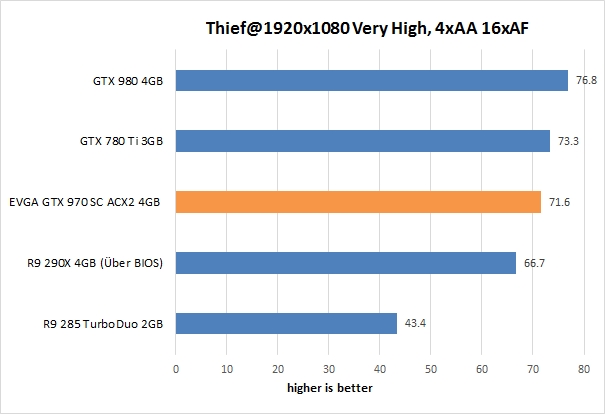
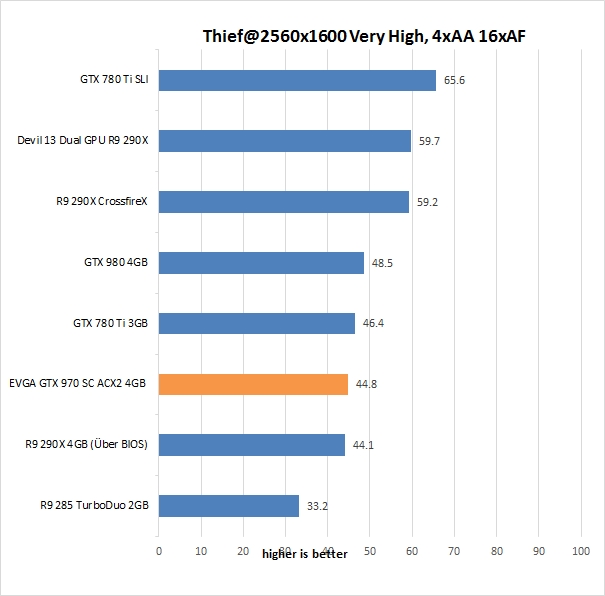
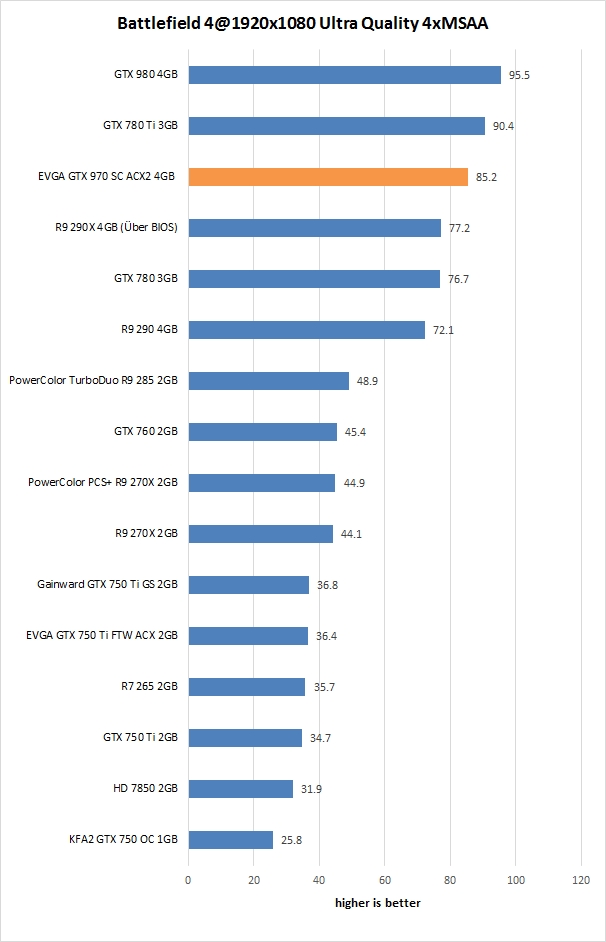
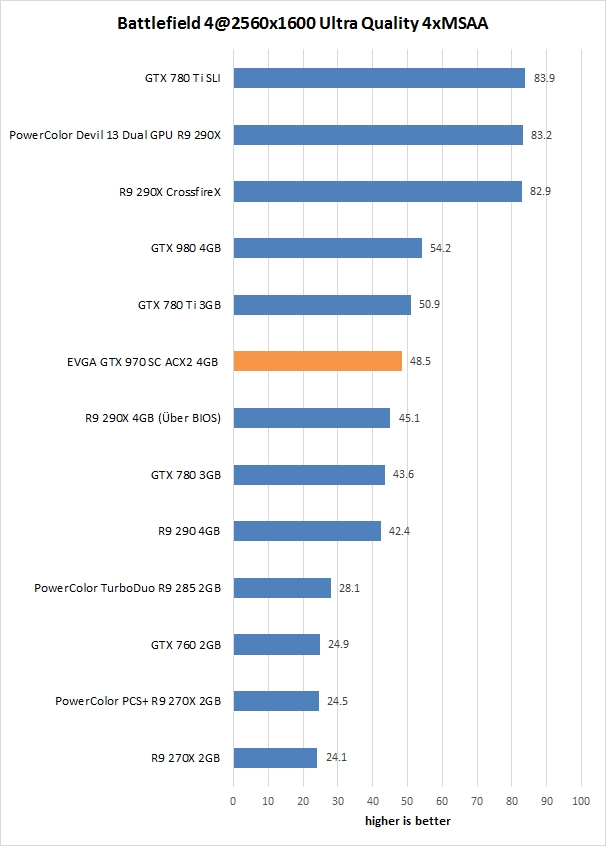
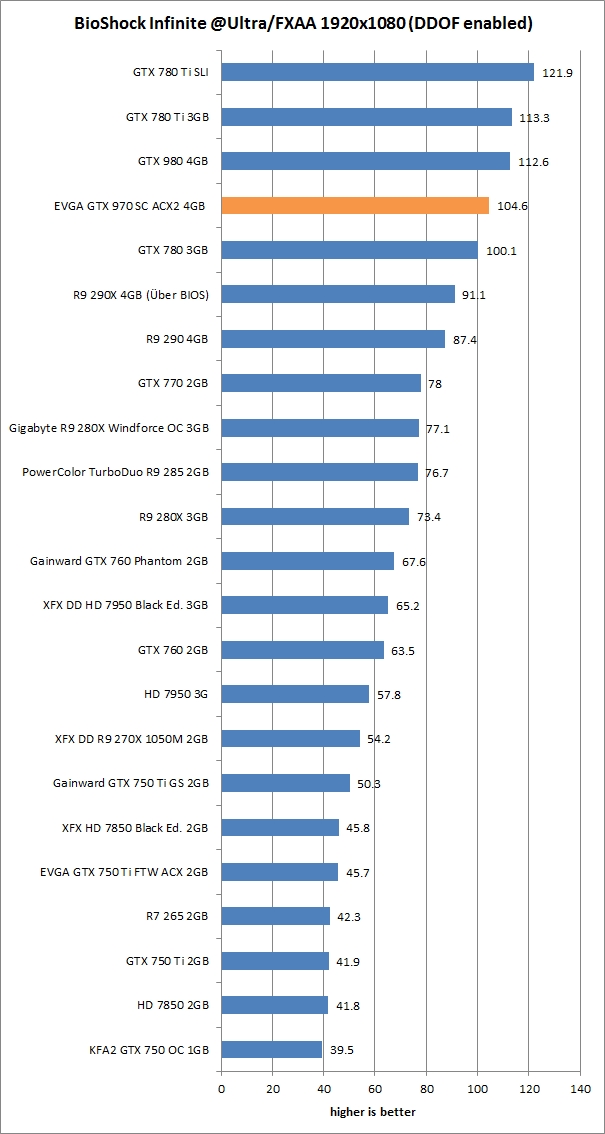
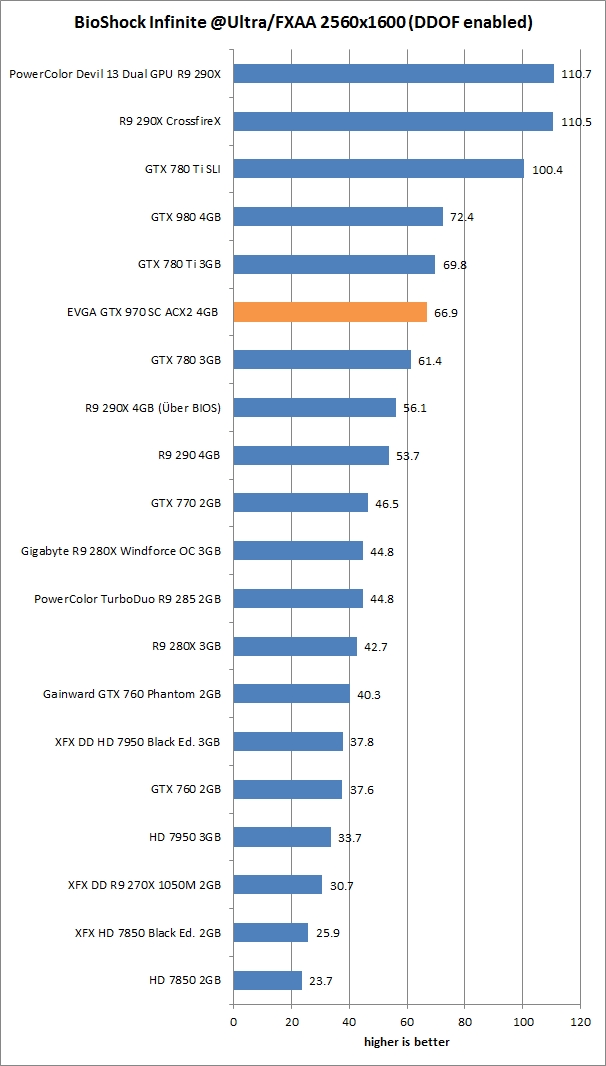
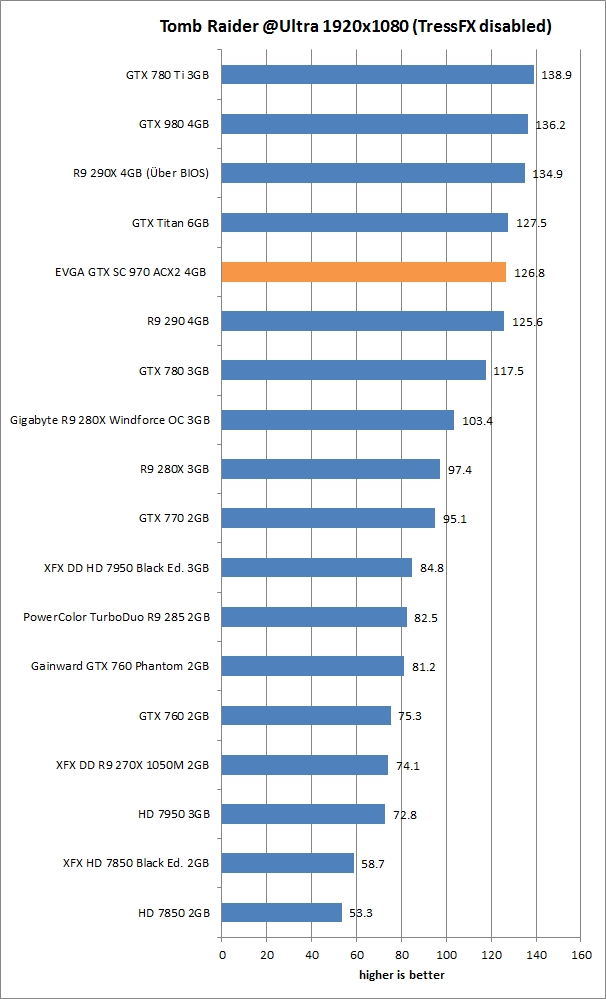

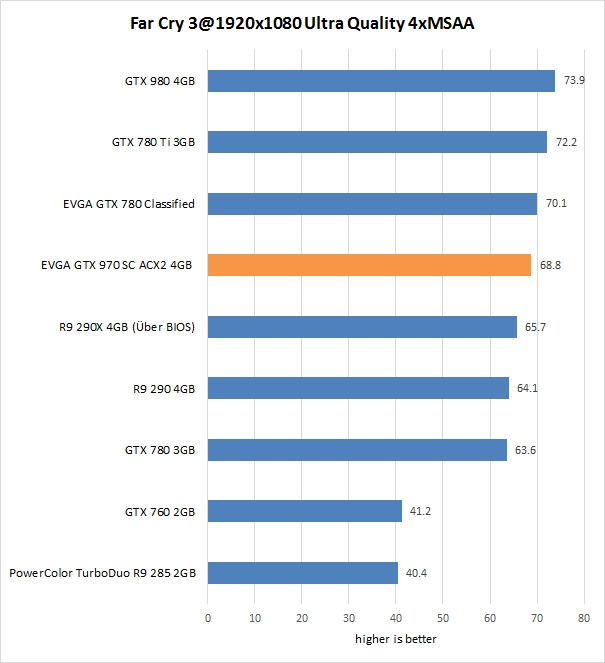
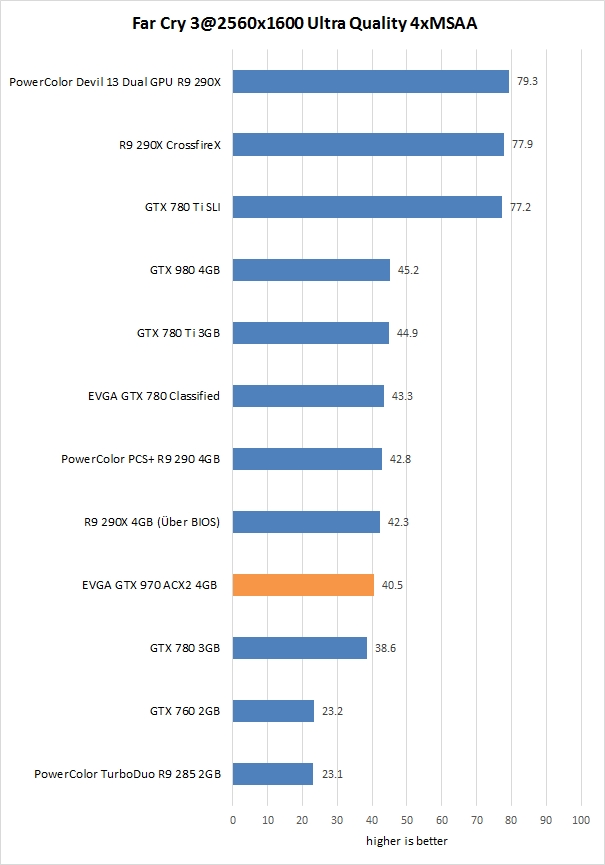
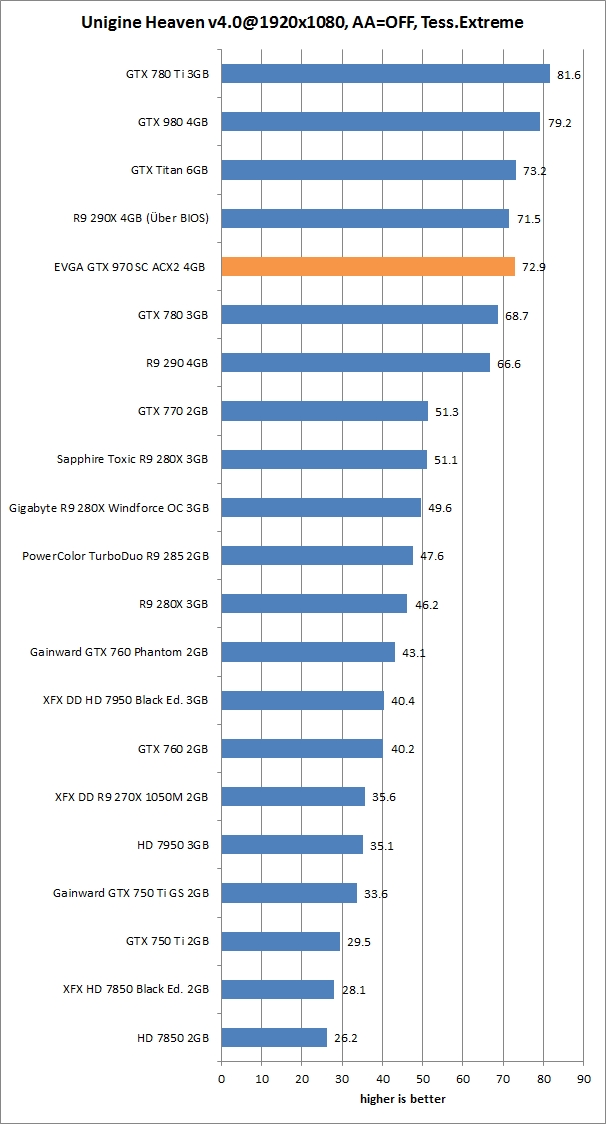
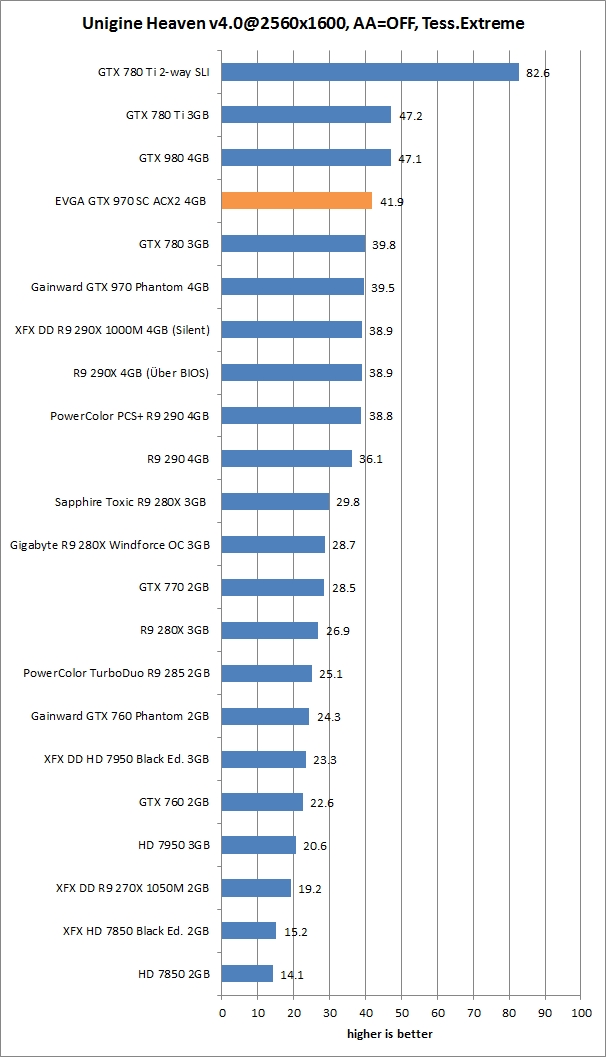
EVGA understands that some reviewers/users have expressed concerns over the fan noise during idle on the EVGA GTX 970 cards. The fan curve is set too aggressive by the default BIOS, but EVGA will provide a BIOS update to reduce the fan noise during idle. However, the fan curve can be easily adjusted in EVGA PrecisionX or any other overclocking software.
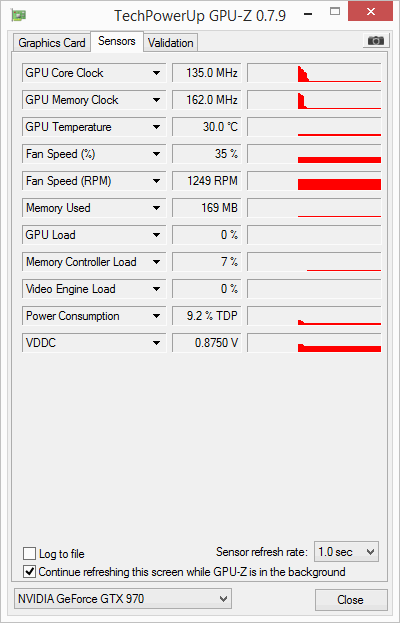
The new ACX 2.0 cooler ships in two different versions, one with three heatpipes and one with five heatpipes. The GTX 970 Superclocked uses the weaker version, while the GTX 970 FTW gets the top of the line five heatpipe version. Although it uses a simpler heatsink, the GTX 970 SC still manages to keep GPU temperatures below 71 degrees Celsius.
The fans are not loud in 3D, but we did not like the relatively quiet but still apparent noise emitted by the power circuitry under load.
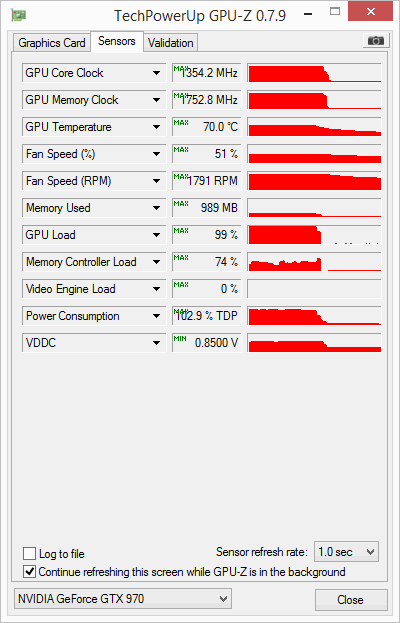
You can use Precision X for monitoring and control of the fan speed.
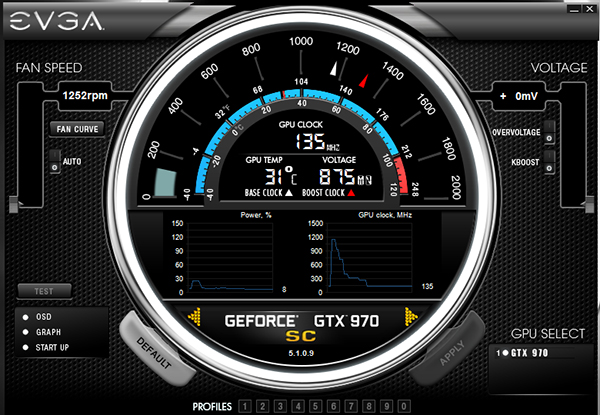
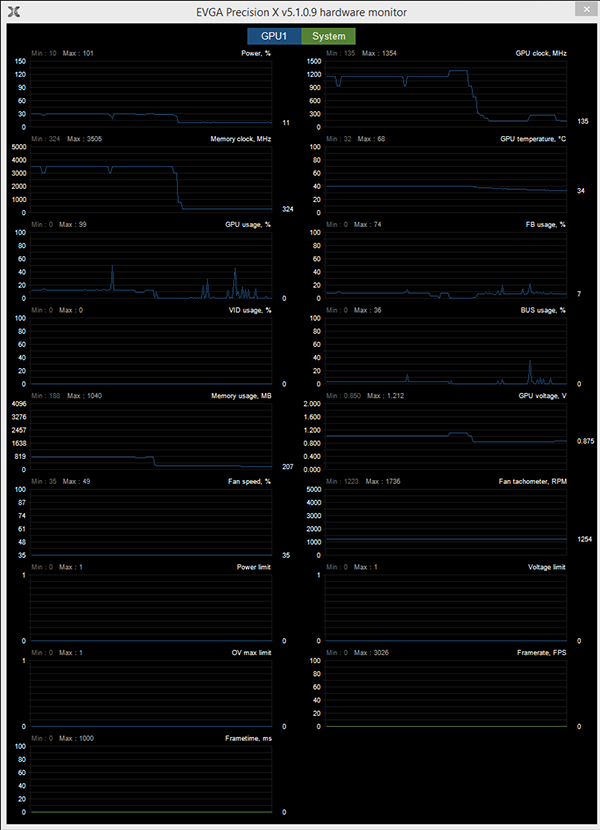
The GTX 980 and GTX 970 do not bring a huge performance boost compared to the previous generation, but they proves Maxwell is vastly more efficient than Kepler. The GTX 980 has a TDP of just 165W and GTX 970 has a TDP of just 145W. For comparison, the mid-range R9 270X has a TDP of 180W, while AMD’s latest R9 285 needs 190W of power. The old Tahiti-based R9 280 has a TDP of 200W, while the 280X churns out 250W, just like the GTX 780 Ti.
EVGA GTX 970 SC ACX 2.0 consumes a little bit more compared to reference design due the factory overclock.

The GTX 970 SC ACX 2.0 works at 1165MHz base, while the reference GPU base clock is set at 1050MHz. Nvidia's GPU Boost 2.0 takes on average the GPU clock to 1178MHz for the reference GPU and to 1317MHz for the SC card.
The overclocking potential is very good considering that this is a factory overclocked card. Using standard voltage and AUTO fan settings we managed to push the GPU 135MHz over the factory clocks. Memory overclocking is vital in any attempt to squeeze out more performance from a graphics card. The memory produced average results with a total 140MHz (effective 560MHz) overclock.
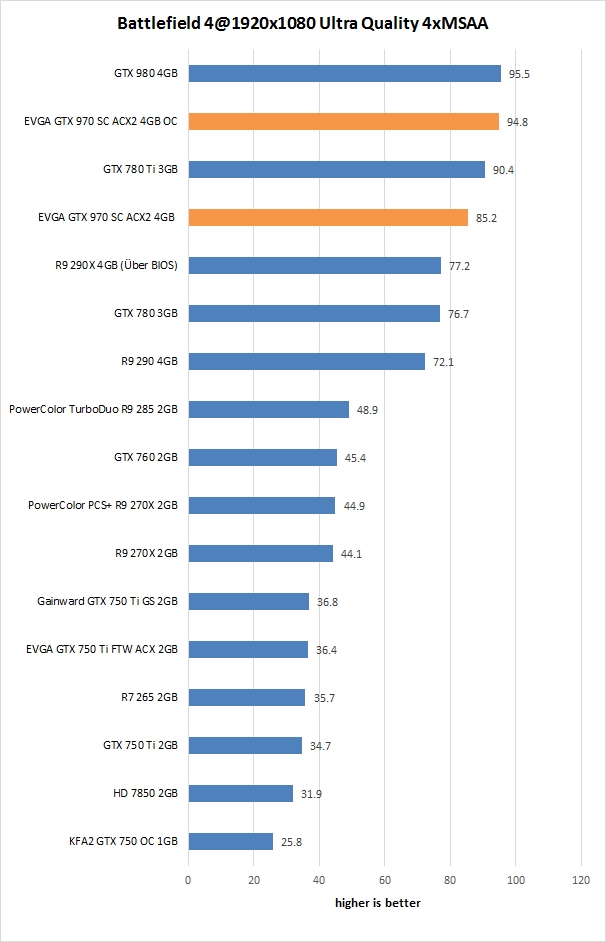
The Maxwell GM204 GPU proves that high-end cards do not have to end up with a huge TDP. Nvidia’s new architecture offers exceptional performance-per-watt and the GTX 970 pumps out just 145W under load.
In many tests the card can outpace the old GTX 780 with a TDP of 250W. Even the new GTX 980 does not end up much faster, so the GTX 970 may offer more value depending on your needs. With a bit of overclocking, the GTX 970 SC can match the reference GTX 980. The GTX 980 is for enthusiasts looking to buy the best single-GPU card on the market, while the GTX 970 is for value minded gamers who want the best bang for their buck.
With the GTX 970 SC ACX 2.0, EVGA has introduced a factory overclocked card capable of matching the GTX 780 Ti in some tests. Resolutions of up to 2560x1600 should not be a problem, but if you need 4K performance you will need two of these cards if you want to crank up the eye candy.
EVGA is constantly working to improve its custom components and come up with cards capable of trumping the competition. There is a range of custom cards with two different ACX 2.0 coolers. The GTX 970 SC ACX 2.0 is the cheaper of the two, while the flagship five heatpipe model is reserved for FTW cards. However, even this entry level version (if you can call it that), did not disappoint either in terms of performance or noise levels. We must note that we were distracted by the noise emitted by the card’s power components under load. Although it is audible at close range, we could not hear it once we buttoned up the chassis.
Nvidia launched three new technologies along with the GTX 980/ GTX 970. Voxel Global Illumination (VXGI) offers an efficient way of computing dynamic global illumination in real time, while MFAA can in theory deliver effects similar to 4xMSAA at a much lower computational cost.
Nvidia’s drivers are not ready yet and it is currently impossible to try out the new multi-frame antia-aliasing (MFAA) feature. Once the drivers are optimized, it is very likely that Kepler cards will lose to new Maxwell products.
Dynamic Super Resolution (DSR) provides an easy way for gamers to improve the image quality in less demanding or older games. We saw DSR in a demo and it is up to developers to harness this power in games. DSR is universal and can be applied to any game by activating it in the driver.
Since the GTX 980 and GTX 970 don’t deliver much of a performance gain, users of 780-series cards have no reason to upgrade if the only thing they want is higher performance. However, those coming from an older card do. What’s more, thanks to their efficiency, Nvidia’s new 900-series cards could even be used to upgrade gaming rigs originally based on mid-range components, with relatively weak PSUs. Our tests prove that you don’t need a massive PSU to build a high-end gaming rig with Maxwell graphics and this saves money both during the build and in the long run. Let’s not forget the somewhat lower electric bill, either.
In terms of pricing, it should be noted that the GTX 980 launches with a suggested retail price of $549, while the GTX 970 is priced at $329. EVGA GTX 970 SC ACX is priced at $349, which is only a small premium over the NVIDIA reference GTX 970 board. The premium buys you a factory overclocked card with the new ACX 2.0 cooler which unlocks even more OC potential.
Since Maxwell is Nvidia’s tenth GPU generation, EVGA is offering a promotion in honor of the new cards. For this promotion, EVGA is giving away three GTX 980 and six GTX 970 graphics cards. The Giveaway is already active and one or two cards will be handed out between September 19 and September 26. You can find more information here.

